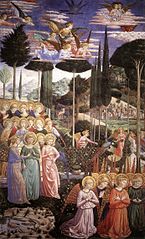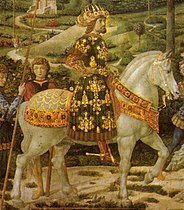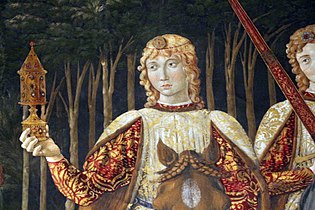
Fra Angelico, OP was a Dominican friar and Italian painter of the Early Renaissance, described by Giorgio Vasari in his Lives of the Artists as having "a rare and perfect talent". He earned his reputation primarily for the series of frescoes he made for his own friary, San Marco, in Florence, then worked in Rome and other cities. All his known work is of religious subjects.

Filippino Lippi was an Italian painter working in Florence, Italy during the later years of the Early Renaissance and first few years of the High Renaissance.

Domenico Veneziano was an Italian painter of the early Renaissance, active mostly in Perugia and Tuscany.
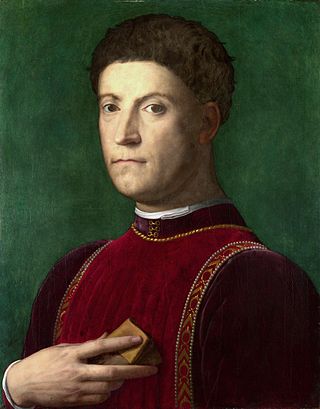
Piero di Cosimo de' Medici, known as Piero the Gouty, was the de facto ruler of Florence from 1464 to 1469, during the Italian Renaissance.

The Adoration of the Magi or Adoration of the Kings or Visitation of the Wise Men is the name traditionally given to the subject in the Nativity of Jesus in art in which the three Magi, represented as kings, especially in the West, having found Jesus by following a star, lay before him gifts of gold, frankincense, and myrrh, and worship him. It is related in the Bible by Matthew 2:11: "On entering the house, they saw the child with Mary his mother; and they knelt down and paid him homage. Then, opening their treasure chests, they offered him gifts of gold, frankincense, and myrrh. And having been warned in a dream not to return to Herod, they left for their own country by another path".

Benozzo Gozzoli was an Italian Renaissance painter from Florence. A pupil of Fra Angelico, Gozzoli is best known for a series of murals in the Magi Chapel of the Palazzo Medici-Riccardi, depicting festive, vibrant processions with fine attention to detail and a pronounced International Gothic influence. The chapel's fresco cycle reveals a new Renaissance interest in nature with its realistic depiction of landscapes and vivid human portraits. Gozzoli is considered one of the most prolific fresco painters of his generation. While he was mainly active in Tuscany, he also worked in Umbria and Rome.

Filippo Lippi, also known as Lippo Lippi, was an Italian painter of the Quattrocento and a Carmelite priest. He was an early Renaissance master of a painting workshop, who taught many painters. Sandro Botticelli and Francesco di Pesello were among his most distinguished pupils. His son, Filippino Lippi, also studied under him and assisted in some late works.

Michelozzo di Bartolomeo Michelozzi was an Italian architect and sculptor. Considered one of the great pioneers of architecture during the Renaissance, Michelozzo was a favored Medici architect who was extensively employed by Cosimo de' Medici. He was a pupil of Lorenzo Ghiberti in his early years, and later collaborated with Donatello.

The Palazzo Vecchio is the town hall of Florence, Italy. It overlooks the Piazza della Signoria, which holds a copy of Michelangelo's David statue, and the gallery of statues in the adjacent Loggia dei Lanzi.

The Palazzo Medici, also called the Palazzo Medici Riccardi after the later family that acquired and expanded it, is a Renaissance palace located in Florence, Italy. It is the seat of the Metropolitan City of Florence and a museum.
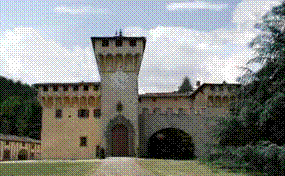
The Villa Medicea di Cafaggiolo is a villa situated near the Tuscan town of Barberino di Mugello in the valley of the River Sieve, some 25 kilometres north of Florence, central Italy. It was one of the oldest and most favoured of the Medici family estates, having been in the possession of the family since the 14th century, when it was owned by Averardo de' Medici. Averardo's son, Giovanni di Bicci de' Medici, is considered to be the founder of the Medici dynasty.
The decade of the 1460s in art involved some significant events.
The decade of the 1450s in art involved many significant events, especially in sculpture.
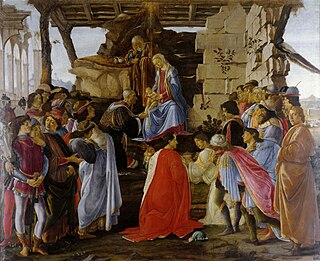
The Adoration of the Magi is a painting by the Italian Renaissance master Sandro Botticelli. Botticelli painted this piece for the altar in Gaspare di Zanobi del Lama's chapel in Santa Maria Novella around 1475. This painting depicts the Biblical story of the Three Magi following a star to find the newborn Jesus. The image of the altarpiece centers on the Virgin Mary and the newborn Jesus, with Saint Joseph behind them. Before them are the three kings who are described in the New Testament story of the Adoration of the Magi. The three kings worship the Christ Child and present him with gifts of gold, frankincense and myrrh. In addition, the Holy Family is surrounded by a group of people who came to see the child who was said to be the son of God.

Seven Saints is a tempera on panel painting by the Italian Renaissance master Filippo Lippi, dating to c. 1449–1459, in the collection of the National Gallery, London. It is a pendant to Lippi's Annunciation, also in the National Gallery. The lunettes were commissioned as part of the decoration of the Palazzo Medici in Florence, where they were likely placed above a door or a bed.

The Annunciation is a tempera on panel painting by the Italian Renaissance master Filippo Lippi, dating to c. 1449–1459, in the collection of the National Gallery, London. It is a pendant to Lippi's Seven Saints, also in the National Gallery. The lunettes were commissioned as part of the decoration of the Palazzo Medici in Florence, where they were likely placed above a door or a bed.
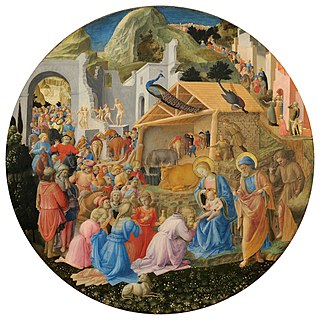
The Adoration of the Magi is a tondo, or circular painting, of the Adoration of the Magi assumed to be that recorded in 1492 in the Palazzo Medici Riccardi in Florence as by Fra Angelico. It dates from the mid-15th century and is now in the National Gallery of Art in Washington D.C. Most art historians think that Filippo Lippi painted more of the original work, and that it was added to some years after by other artists, as well as including work by assistants in the workshops of both the original masters. It has been known as the Washington Tondo and Cook Tondo after Herbert Cook, and this latter name in particular continues to be used over 50 years after the painting left the Cook collection.

Medici is a historical drama television series created by Frank Spotnitz and Nicholas Meyer. The series was produced by Italian companies Lux Vide and Rai Fiction, in collaboration with Frank Spotnitz's Big Light Productions.

The Mystical Nativity or Adoration in the Forest was painted by Fra Filippo Lippi around 1459 as the altarpiece for the Magi Chapel in the new Palazzo Medici in Florence. It is now in the Gemäldegalerie, Berlin, with a copy by another artist now hanging in the chapel. It is a highly individual depiction of the familiar scene of the Nativity of Jesus in art, placed in a mountainous forest setting, with debris from woodcutting all around, rather than the familiar stable in Bethlehem, and with the usual figures and animals around the mother and child replaced by others.
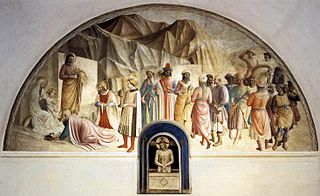
The Adoration of the Magi in San Marco is a fresco by Fra Angelico in a double cell used by Cosimo de' Medici, created c. 1441-1442.













